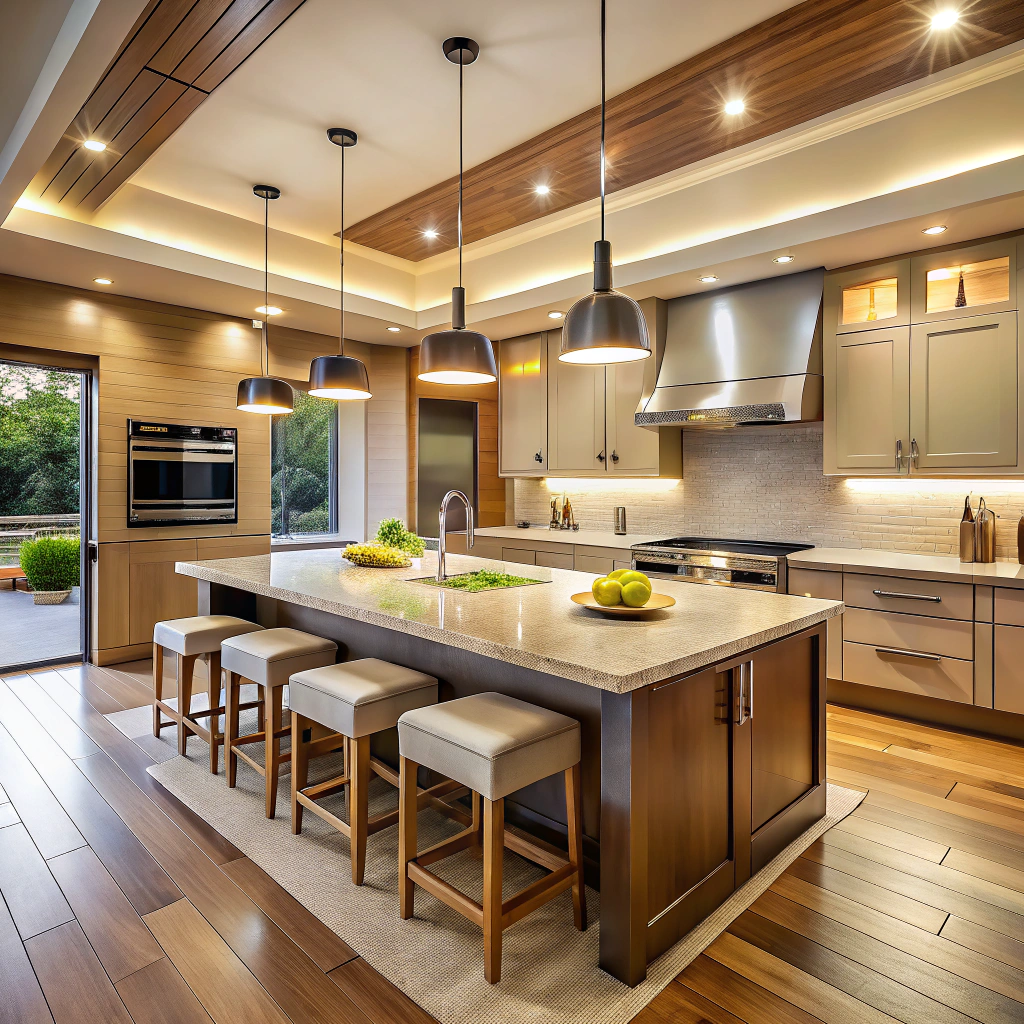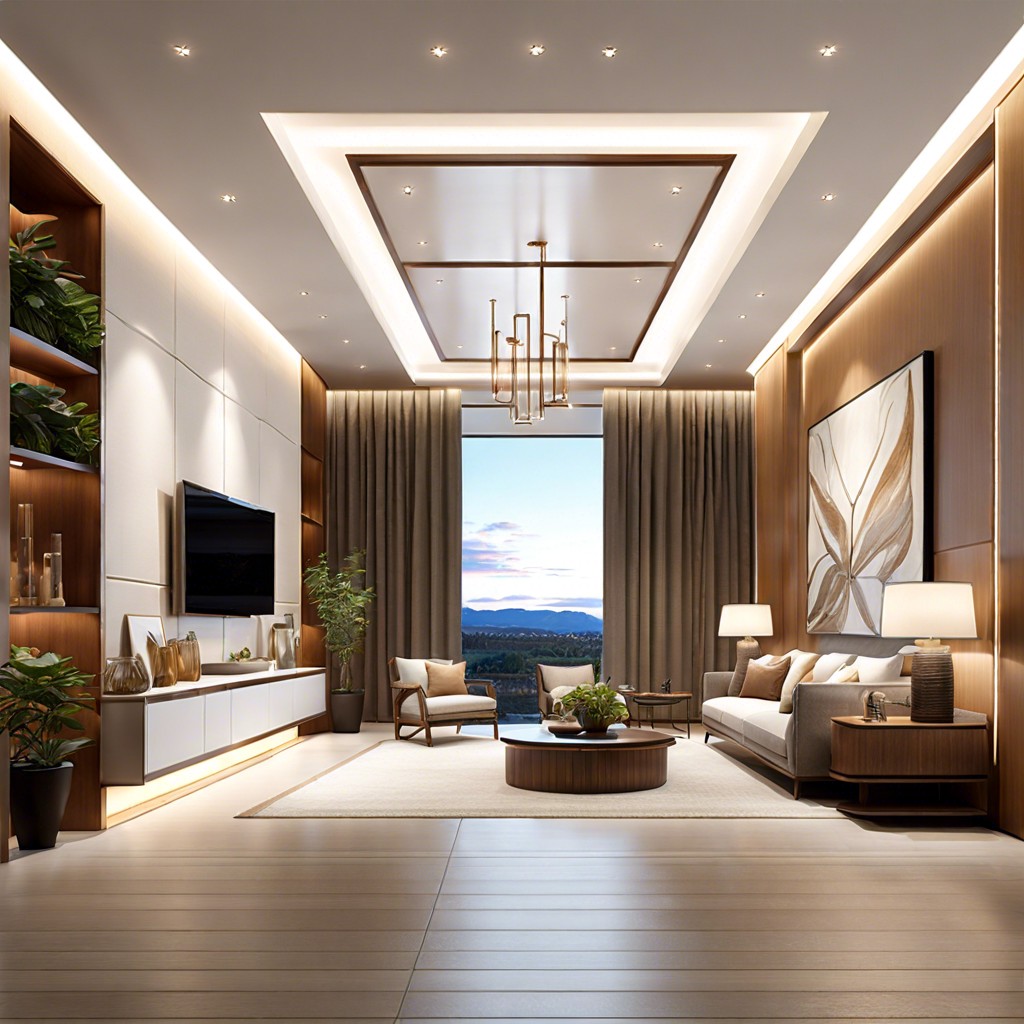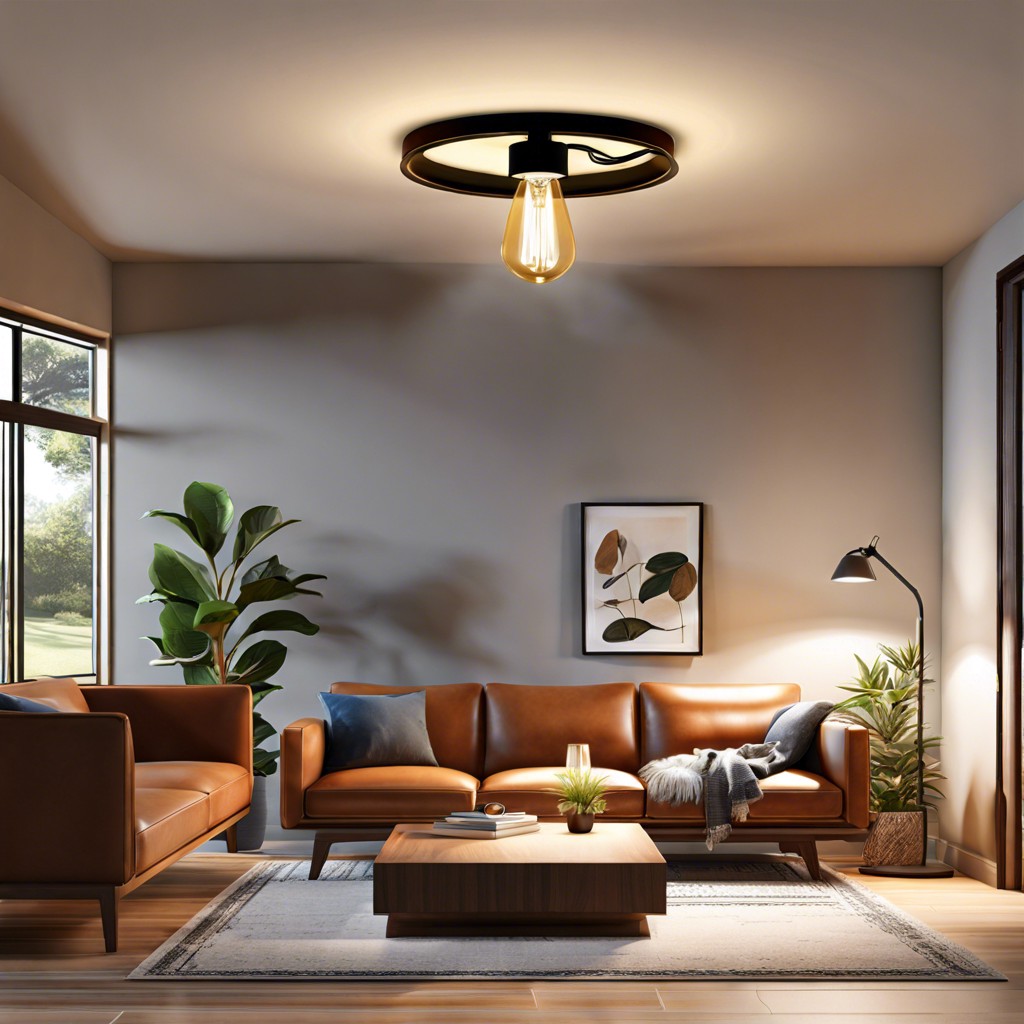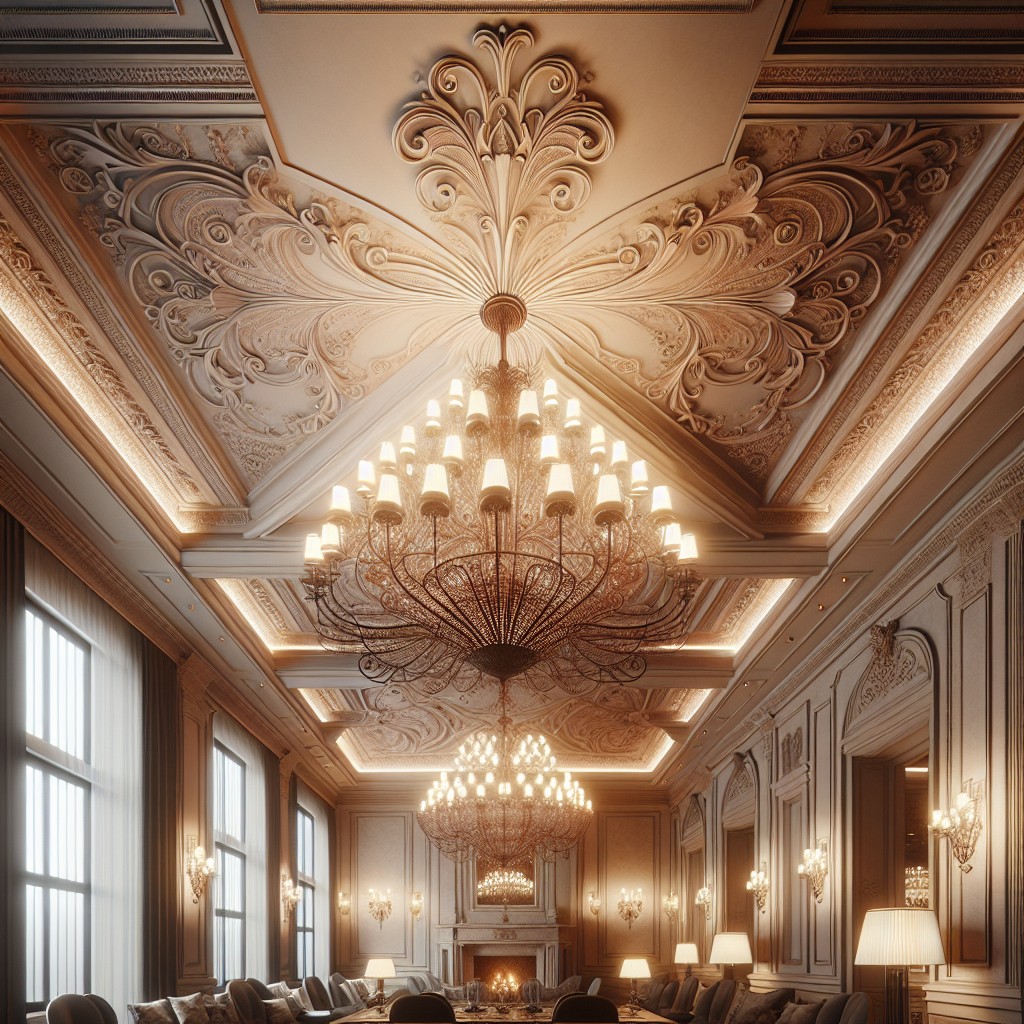Last updated on
Upgrading to daylight LED recessed light bulbs instantly enhances home decor because these brilliant lights create a natural ambiance while providing ample illumination.
These are my unique design concepts made using design tools. I hope you find them inspiring!
Harnessing the benefits of daylight LED recessed lightbulbs has become increasingly popular, but there is still plenty of unexplored terrain regarding creative ways to utilize them. From brightening up dull corners to creating ambience or even appearances of larger spaces, these bulbs offer a plethora of design possibilities.
This article will delve into new, innovative ideas to maximize the potential of these lighting wonders, ranging far beyond the standard recommendations typically found on the internet. Though homage will be paid to some classic, tried-and-true ideas with relevant resources included at the end, the heart of this piece lies in the fresh, unique perspectives that promise to inspire your next lighting project.
Let’s enlighten ourselves further, shall we?
What's Inside
Exploring The Benefits of Daylight LED Recessed Lighting
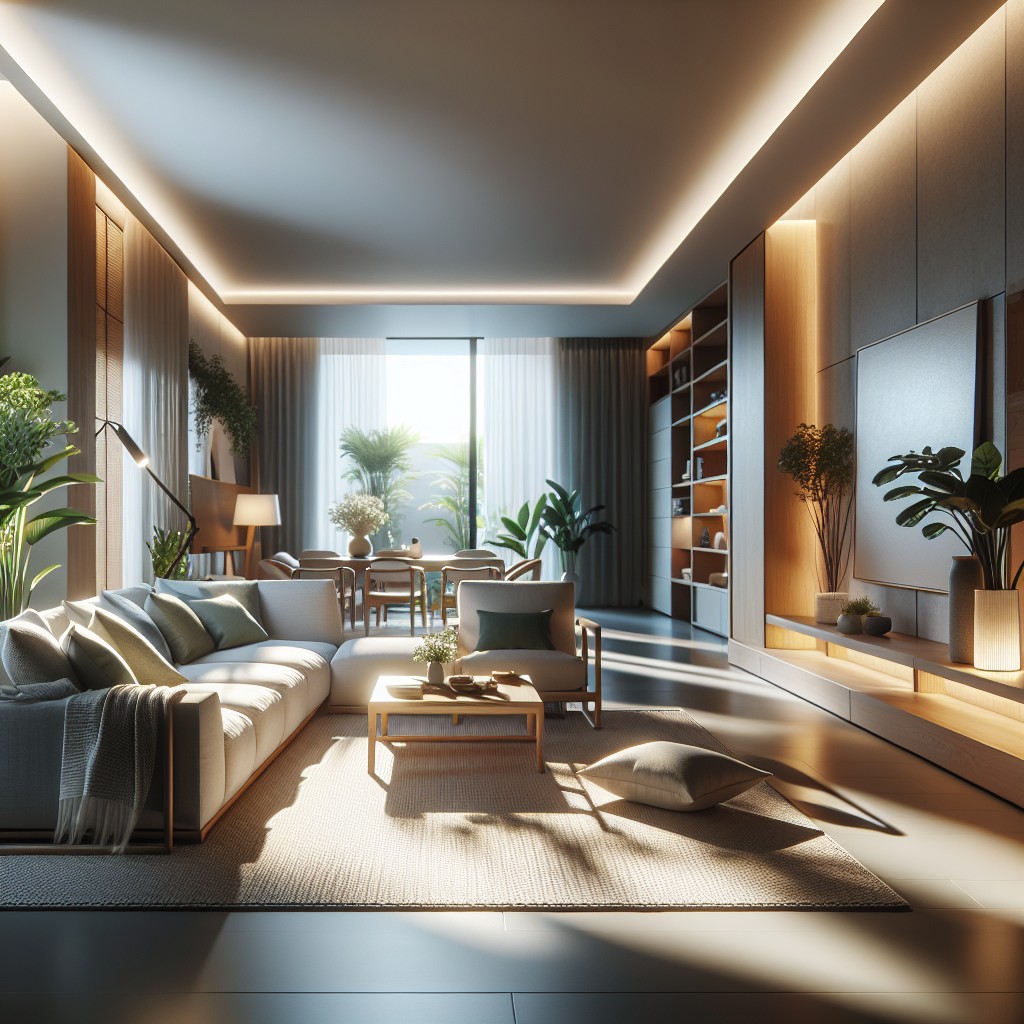
Various advantages make daylight LED recessed lights a popular choice for home decorators. Foremost among these is the clean, crisp light they emit, mimicking natural daylight and instantly brightening any room. This quality of light enhances visibility and can help reduce eye strain, particularly in areas like study rooms and home offices.
Another notable benefit is their design versatility. These lights provide a sleek, modern aesthetic to any space, without protruding from the ceiling. This feature lends a smooth and seamless look to rooms, making them appear more spacious.
Moreover, daylight LED lights are known for their high energy efficiency. They use less power compared to traditional lighting options while offering superior illumination. Additionally, these lights are notably long-lasting, reducing the need for frequent bulb changes and contributing to their cost-effectiveness in the long run.
Lastly, LED lights do not generate much heat, making them a safer choice. This advantage reduces the risk of burns or fires, proving them to be a practical choice for residential lighting.
The Impact of Daylight LED Recessed Light Bulbs On Room Ambience
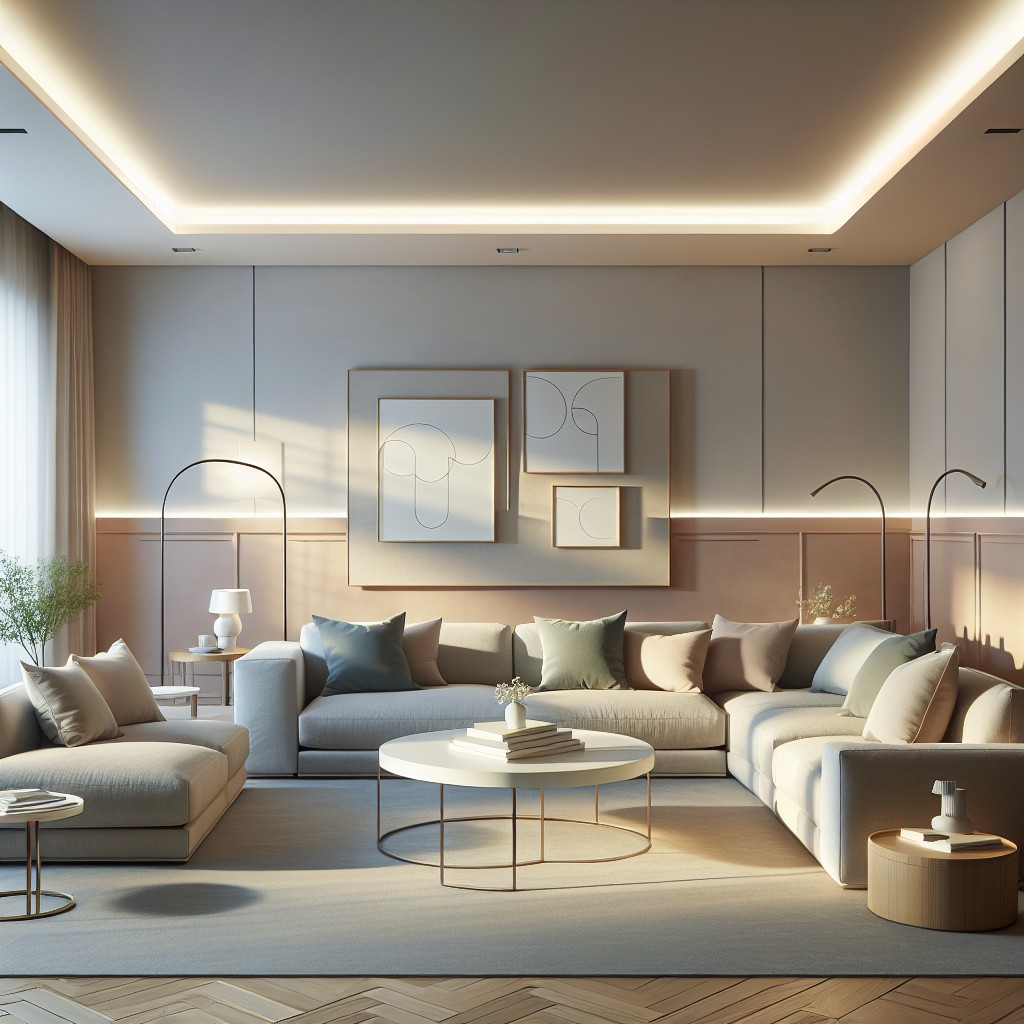
When it comes to setting the mood in a room, daylight LED recessed lights play a defining role. These lights mimic natural daylight, bringing vibrancy to your interiors. Having them installed in your ceiling, you get a neat, space-enhancing look, with the lights blending easily into the design.
One major highlight is the way they illuminate a room—casting light downwards and outwards, reducing shadows and offering even distribution of light across space. This means no corner remains dark, bestowing a bright, open feel to the room, making it appear larger and more inviting.
Moreover, the clarity and brightness of daylight LEDs make colors pop. Whether it’s the vibrant splash of a painting or the subtle hue of your wallpaper, every detail stands out with perfect clarity. In case of rooms with a lot of natural materials, such as wood or stone, the daylight hue highlight the beauty of these materials, accenting their natural textures.
However, keep in mind that they’re most optimal in functional rooms where brighter illumination enhances productivity, like the kitchen or a home office. Also, consider leveraging dimmers for increased versatility, moving smoothly from functional to ambient lighting as needed.
Fitting Daylight LED Recessed Lights in Your Home
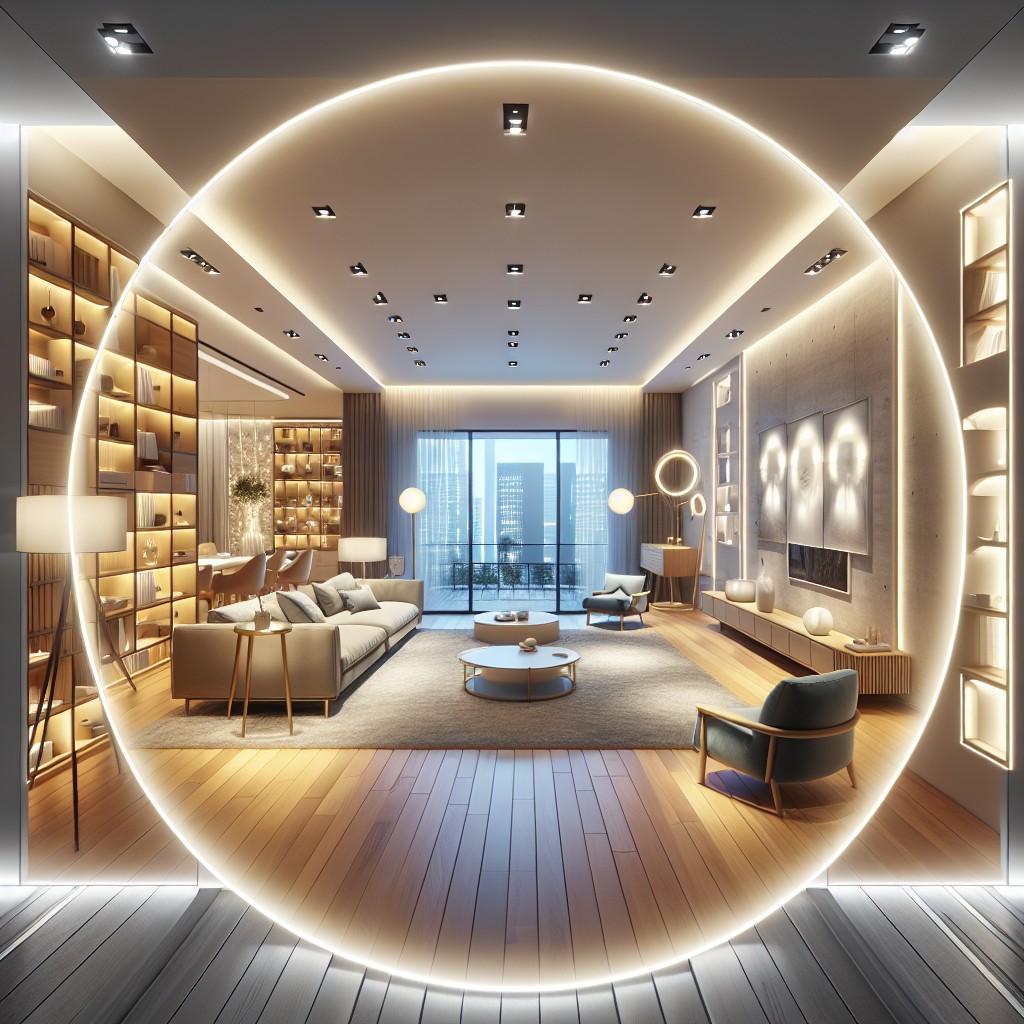
To fit daylight LED recessed lights in your home, a few crucial considerations should be made. First, determine the purpose of the light; is it for general, task or accent lighting? The main area would benefit from general lighting while countertops or reading areas need task lighting. Accent lighting, often used to highlight a piece of art, requires a focused beam.
Distance between fixtures should be calculated ideally at half the distance of the ceiling height. For example, if the ceiling is 8 feet high, place the fixtures every 4 feet. This ensures a smooth and evenly dispersed light.
The lighting scheme will need to have the right trim – the visible part of the light. Consider using a baffle trim for reduced glare, or a reflector trim for optimized light.
Furthermore, the dimming feature is popular for adjustable ambiance. However, ensure the LEDs installed are ‘dimmable’ as not all have this capability. If adjustable lighting isn’t required, skip this step.
Last but not least, safety comes first. Electricity is involved, so don’t hesitate to seek help from a professional if needed. They can assure fixtures are wired correctly, minimizing risk of shock or fire. Remember, placing a light in the right area is as important as the type of light chosen.
Top Brands for Daylight LED Recessed Lights

Ensuring quality and durability of your lighting is easy thanks to some top-notch brands in the market.
Philips is a well-established and globally recognized brand offering a wide selection of daylight LED recessed light bulbs. Their models provide superior brightness and a long lifespan making them a reliable choice.
GE Lighting also has an impressive array of options, specializing in energy-efficient LED bulbs that mimic the feel of natural sunlight. They present a balance of function, efficiency, and design in their product range.
On the other hand, Cree, a leading innovator of lighting-class LEDs, offers daylight LEDs that create perfect light distribution, reducing hotspots and shadowing in your space.
Another noteworthy brand is Lithonia lighting, well-regarded for their exceptional luminance and energy-saving capabilities. Their designs often focus on showing off a clean, uncluttered look, perfect for modern aesthetics.
Finally, Sylvania lighting designs offer sleek illumination with a design aesthetic that tailors to both classic and contemporary tastes. Their LEDs deliver high performance with clear, crisp daylight illumination.
Remember, choosing a brand often depends on individual lighting requirements, preferred design aesthetics, and budget. Always pick based on your specific needs to ensure your space is lit effectively and beautifully.
Energy Efficiency of Daylight LED Recessed Lighting
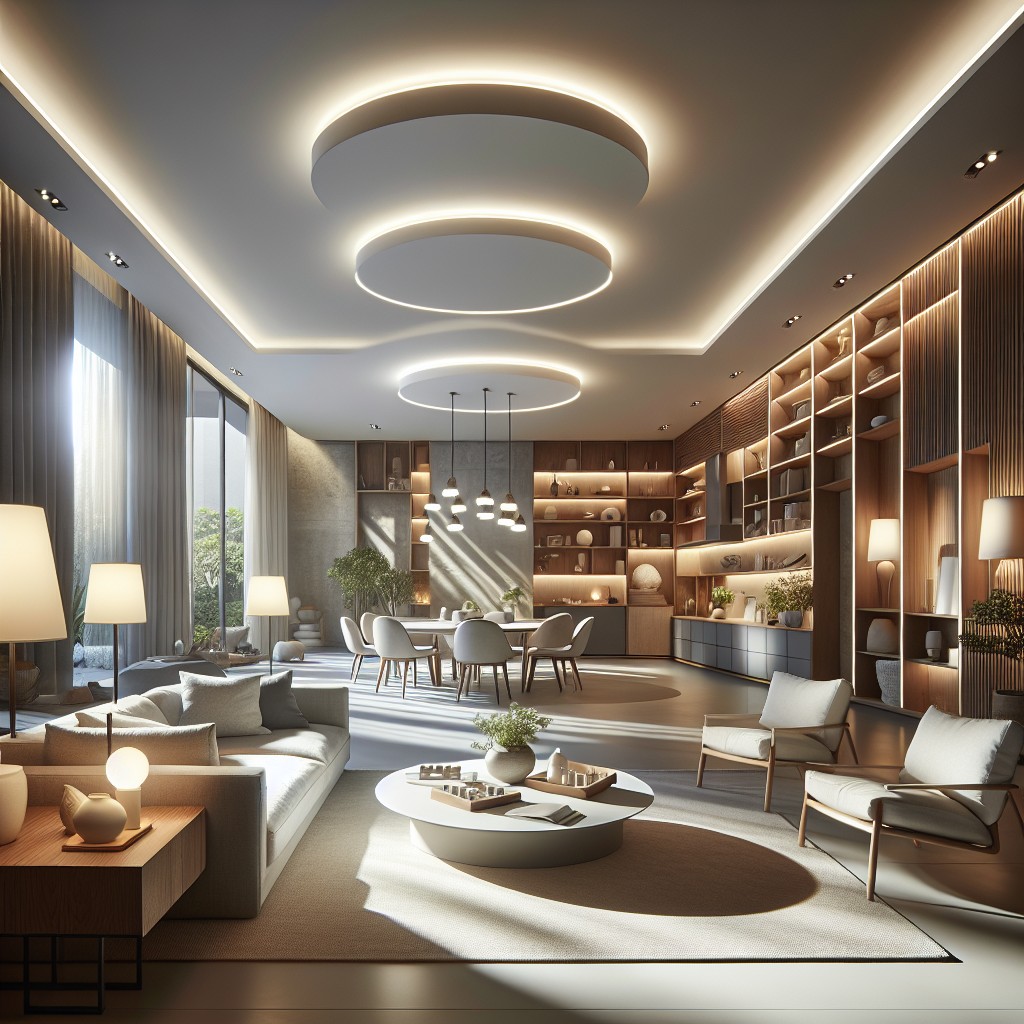
As a powerful source of illumination, daylight LED recessed lighting can reduce your energy bills while providing superior lighting quality. These bulbs typically use around 75% less energy compared to traditional incandescent lights, and they last up to 25 times longer. They also produce almost no heat, adding to their energy efficiency and reducing safety risks.
Daylight LEDs are favored for their high color rendering index (CRI), which reflects how accurately colors appear under the light. This makes them great for tasks requiring keen eyes, even in home settings, such as cooking or crafting.
Switching to LEDs can offer significant savings over time due to their long lifespan and efficiency. For instance, if you replace twenty 60-watt incandescent light bulbs with 9-watt LED bulbs, running for 5 hours per day, you could save up to $300 per year on energy costs.
Energy Star certified LED bulbs go the extra mile in ensuring energy efficiency, as they undergo rigorous testing to meet high standards. Remember to look for the Energy Star logo when shopping for daylight LED recessed lighting. It’s not just about lighting up your rooms, but also about embracing a greener lifestyle.
Using Daylight LED Recessed Lights for Artistic Lighting Effects
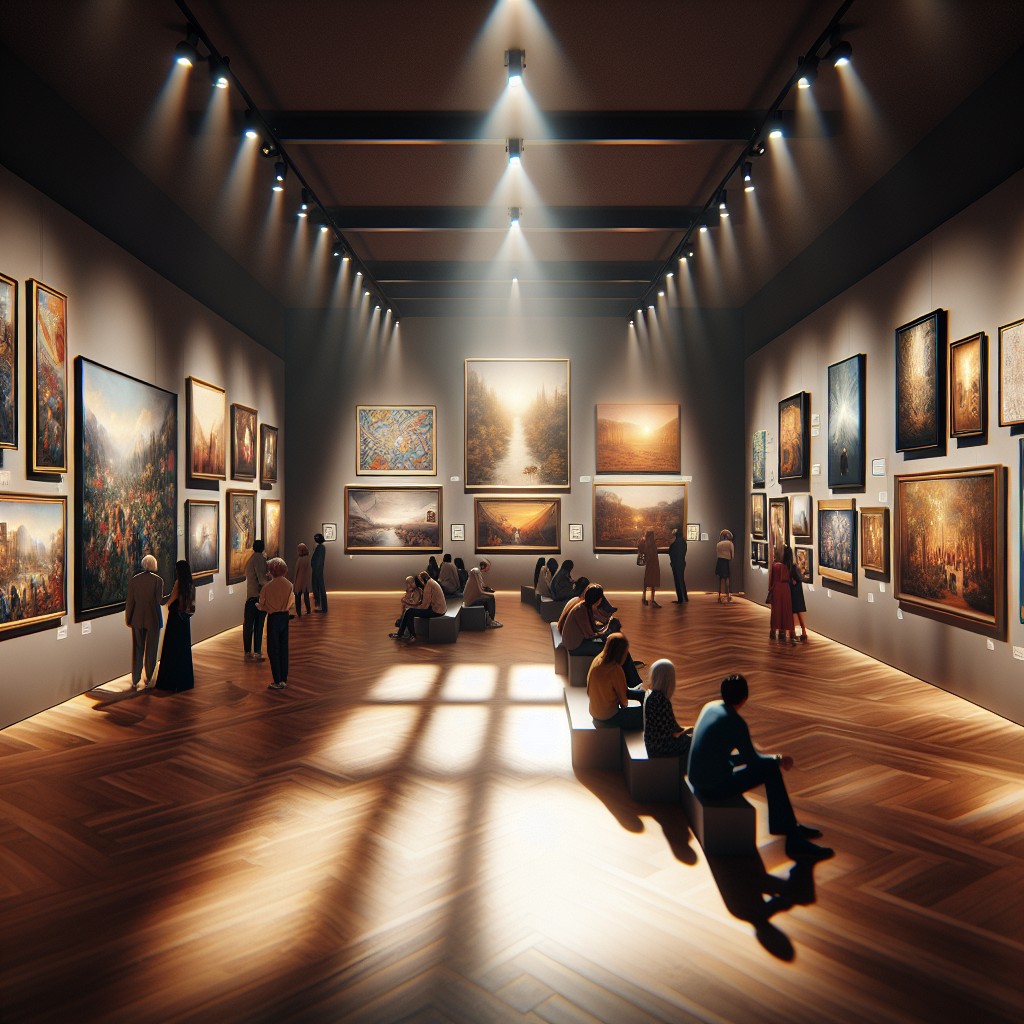
LED recessed lights, given their placement and the unique directional lighting they offer, are exceptional tools for creating stunning artistic lighting effects in your interior spaces.
Firstly, the use of ‘Wall Washing’ is one strategy. This technique involves placing LED lights close to the wall, projecting a soft wash of light that highlights texture and/or color. Daylight LEDs render true colors, allowing featured pieces of artwork or wall designs to shine.
Secondly, ‘Shadowing’ is another trick of the trade. Lighting fixtures are positioned in a way that casts eye-catching shadows onto walls or other architectural features — a prime opportunity for daylight LEDs to create splendid room dimension through contrast.
Lastly, ‘Accent Lighting’ is a well-known approach. Use daylight LED recessed lights to draw attention to specific areas or objects like sculptures or unusual furniture, illuminating them powerfully against a softer background.
Remember, subtlety is key in artistic lighting. By planning fixture placement carefully and considering the impact daylight LEDs will make, you can achieve dramatic, beautiful effects.
Daylight LED Recessed Lights: Perfect for Kitchen Spaces?

Indeed, these lights work marvelously in kitchen spaces due to their brightness and clarity. Their true-to-life daylight hue illuminates every corner, making your kitchen tasks easier.
The specific angle at which the light is emitted makes it ideal for focusing on particular areas, like countertops where you prepare food or the sink where you wash dishes.
Another feature that makes it suitable for kitchens is its effortless blend with most interior styles. Whether your kitchen boasts a modern minimalist look or a cozy rustic charm, these recessed lights will enhance the aesthetic without being overbearing.
Daylight LED recessed lights also contribute to energy efficiency. They consume less electricity compared to traditional light bulbs while providing superior illumination. This factor leads to significant cost savings in the long run, crucial for a high-traffic area like the kitchen.
Overall, these daylight LED recessed lights lend not only functionality but also a stylish, modern touch to the heart of any home – the kitchen.
The Lifespan of a Daylight LED Recessed Light Bulbs
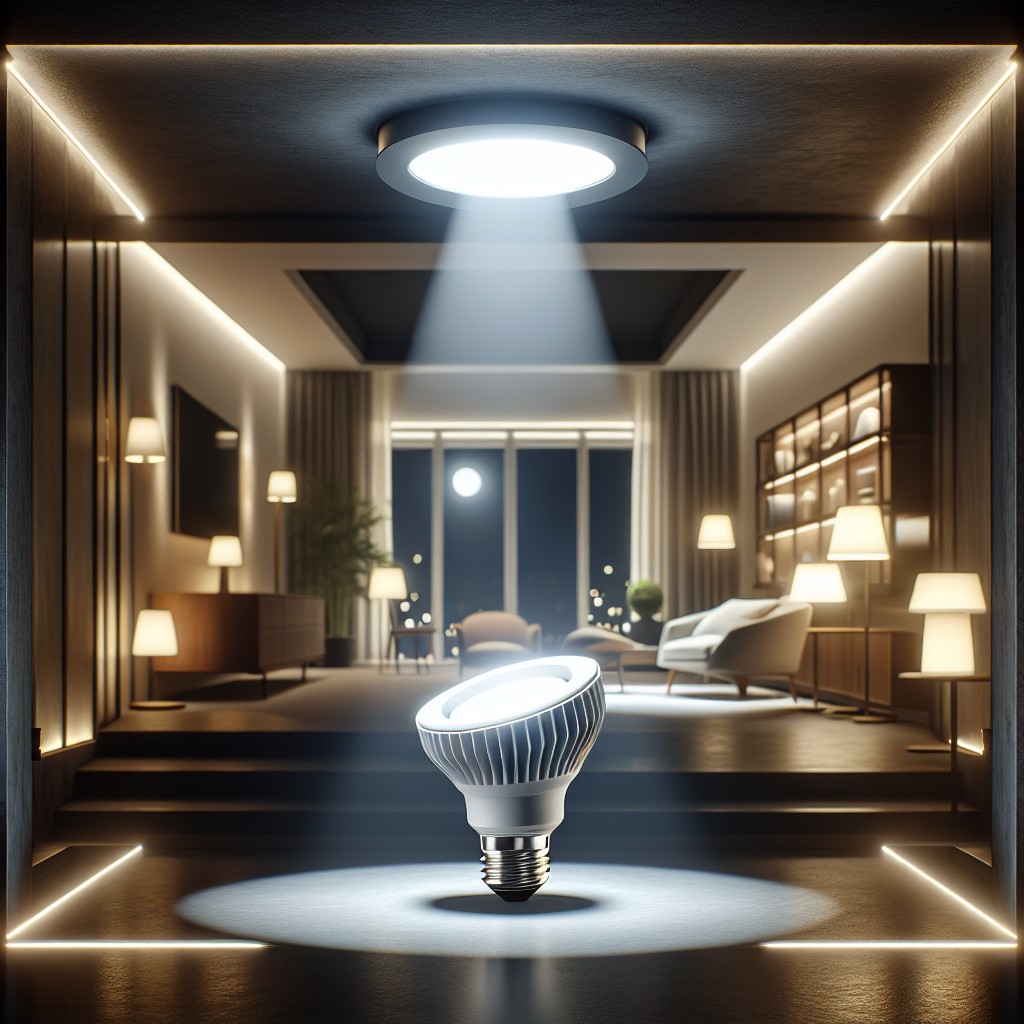
When it comes to durability, the impressive lifespan of these light bulbs is a feature that often catches the attention. Typically, a quality daylight LED recessed light bulb can last around 25,000 to 50,000 hours. This expansive longevity can stretch up to 25 years if used for five hours per day. Therefore, these bulbs not only save energy but also reduce frequent replacement needs, making them a viable choice for homeowners seeking low maintenance options.
The lifespan of LEDs is significantly longer compared to traditional incandescent bulbs, which commonly last for 1000 to 2000 hours, or compact fluorescent light (CFL) bulbs, which usually provide around 8,000 to 10,000 hours of life. Therefore, despite the initial investment in daylight LEDs, the longevity and energy savings generally outweigh the upfront costs.
How Daylight LED Recessed Lights Enhance Certain Color Schemes
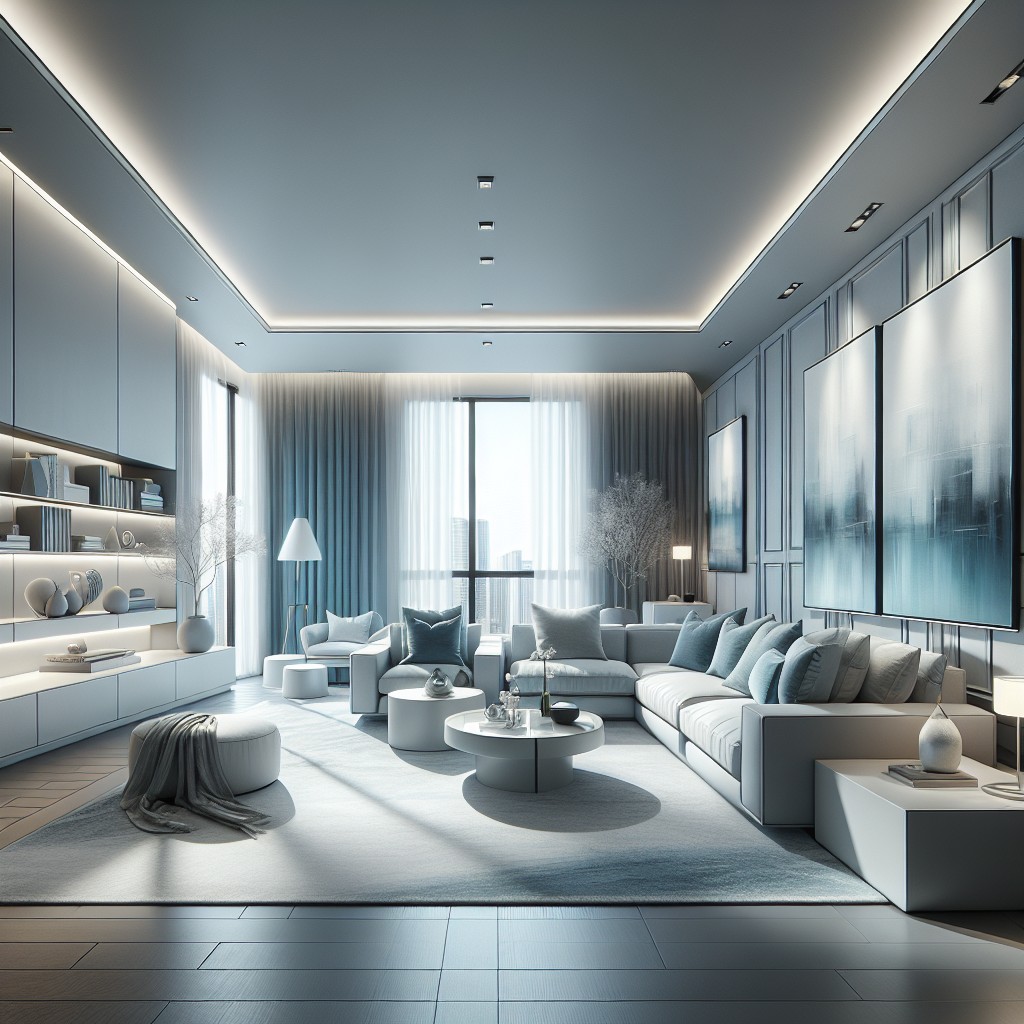
When choosing paint hues or textiles, consider how daylight LED recessed lights can enhance the vividness and authenticity of your color scheme. These lights are exceptional for their ability to reflect true colors, owing to their high Color Rendering Index (CRI). Thus, they can add depth and richness to darker tones, while making lighter shades appear more vibrant and luminous.
For a modern, minimalist feel, introducing these lights in a space with neutral or white shades can create a beautifully crisp, clean feel. Alternatively, in a room with warm tones such as reds, oranges, or browns, daylight LEDs can inject an energetic ambiance.
On the other end of the spectrum, rooms decorated in cool tones like blues and greens can attain a soothing, tranquil atmosphere when lit with these lights. In spaces that feature eclectic or bright hues, they can harmonize the different colors, providing balance and coherence.
Be mindful of the desired atmosphere when lighting your home. Consider your color scheme and the mood you want to evoke, and you’ll realize just how transformative daylight LED recessed lights can be.
How To Choose the Right Daylight LED Recessed Light for Your Space
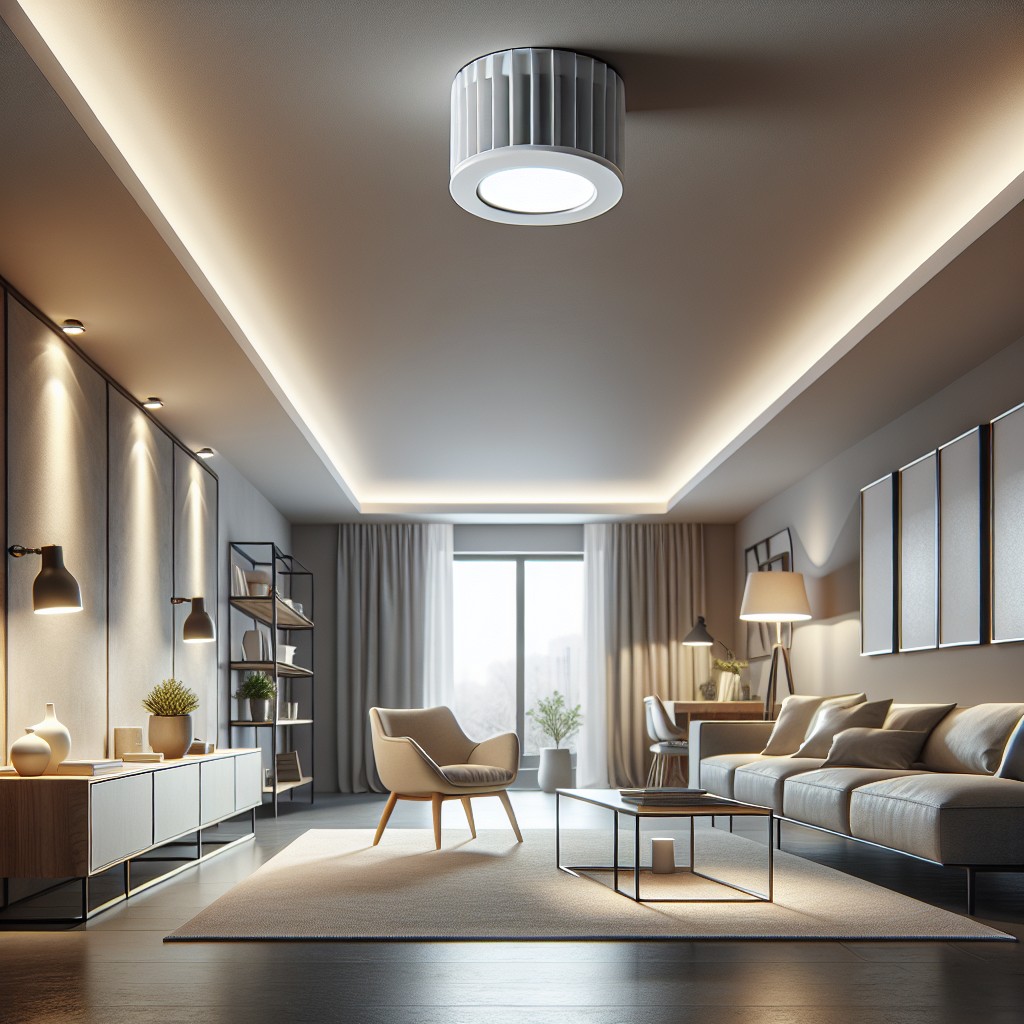
Consider the following aspects when selecting daylight LED recessed lights for your space:
1. Room Size and Ceiling Height: Larger spaces or rooms with high ceilings may require more powerful bulbs or additional fixtures to achieve the desired level of illumination. Consider using a light calculator to determine the exact number of lumens needed.
2. Functionality: Understand your lighting needs. If you need to highlight specific features, consider smaller, adjustable recessed lights. For general lighting, you may want larger, fixed bulbs that disperse more light.
3. Color Temperature: While ‘daylight’ usually means a cooler, bluer hue (5000K-6500K), your preferences may vary. If you want the room to have a warm, cozy atmosphere, opt for LEDs closer to the lower end of the scale.
4. Energy Efficiency: Look at the wattage of the bulb. LEDs are more energy-efficient than traditional lighting options, but variations exist within LED options too.
5. User-Friendliness: Choose lights with accessible, user-friendly controls. Features like dimming capabilities or smart home compatibility can enhance your lighting experience.
6. Quality and Durability: Choose established brands offering long-lasting, durable LED light bulbs with high-quality light output. Some LED recessed lights have a lifespan of up to 50,000 hours.
Always remember, the goal is to match your lighting to your space’s function, decor, and personal comfort.
Modernizing Your Home With Daylight LED Recessed Lighting

As you progress on your route to-refresh your home, one important aspect that can often be overlooked is the lighting. Integrating daylight LED recessed lighting is an excellent strategy for a modern revamp. This approach has numerous benefits.
Firstly, these lights have an uncanny ability to simulate natural light, which can make your spaces feel larger, open, and well-lit. This is typically the distinguishing factor compared to traditional lighting techniques.
Secondly, spotlighting features of décor or architecture can add a touch of sophistication. A strategically placed daylight LED recessed light can accentuate elements like artwork, statement furniture, or striking wall textures.
Lastly, with the advancement in technology, many models now offer dimmable features. This grants you the flexibility to set the lighting ambiance for different moods and occasions. This versatility is a distinct modern trait that can enrich your living experience.
In conclusion, integrating daylight LED recessed lighting is an impactful way to modernize your space and enhance your home’s overall ambiance.
The Installation Process for Daylight LED Recessed Lights

Begin by locating the desired installation area. Carefully measure the space, ensuring it’s suitable and safe for the recessed lighting unit.
Next, inspect the electrical wiring. If installing new wiring, professional assistance is advised to maintain safety standards.
Cut the correct sized hole for your fixture using a hole-saw. Remember, precision is key. Too big, and the fixture will lack support. Too small, and it won’t fit.
Then, safely connect your light fixture to the existing wiring, ensuring all connections are secure. Always keep the power off to prevent electric shocks during this step.
Secure the fixture into the cut-out hole. It should fit snugly.
Following this, connect your daylight LED bulb to the fixture. Handle these bulbs with care as they can be fragile.
Finally, power on and test the installed bulb. Enjoy the fresh, clear illumination of your new daylight LED recessed light. Be prepared to adjust the bulb or fixture if necessary. To ensure an ideal ambiance, balancing brightness and warmth is recommended.
The Return On Investment of Daylight LED Recessed Lighting

If you think about the energy efficiency, lifespan variable and the reduction in maintenance costs, the return on investment for daylight LED recessed lighting becomes noticeable over time. They may be pricier initially compared to traditional bulbs, but they are long-lasting and consume less electricity. This, in turn, can show a significant reduction in your monthly utility bills.
Take the lifespan for instance; these bulbs can last up to 50,000 hours – roughly five times longer than typical CFLs and much longer than traditional incandescent bulbs. This means fewer replacements and hence less maintenance.
On energy efficiency, LED recessed lights use 75% less energy compared to incandescent bulbs, which can truly add up cost savings on your electrical bill. This lower energy consumption also reduces their impact on the environment, which is a crucial aspect to consider when, assessing broader consequences for our planet.
The daylight LED type offers unmatched daylight-like brightness. This can eliminate the need for additional light sources in a room, potentially saving you on fixture costs.
Considering these points, the initial costs of daylight LED recessed lights are outweighed over time, making them a beneficial investment for your home. Remember, while upfront costs might be a bit higher, the long-term energy savings, coupled with reduced replacement costs, could lead to possible significant cost savings over time.
Comparing Daylight to Soft White LED Recessed Lights
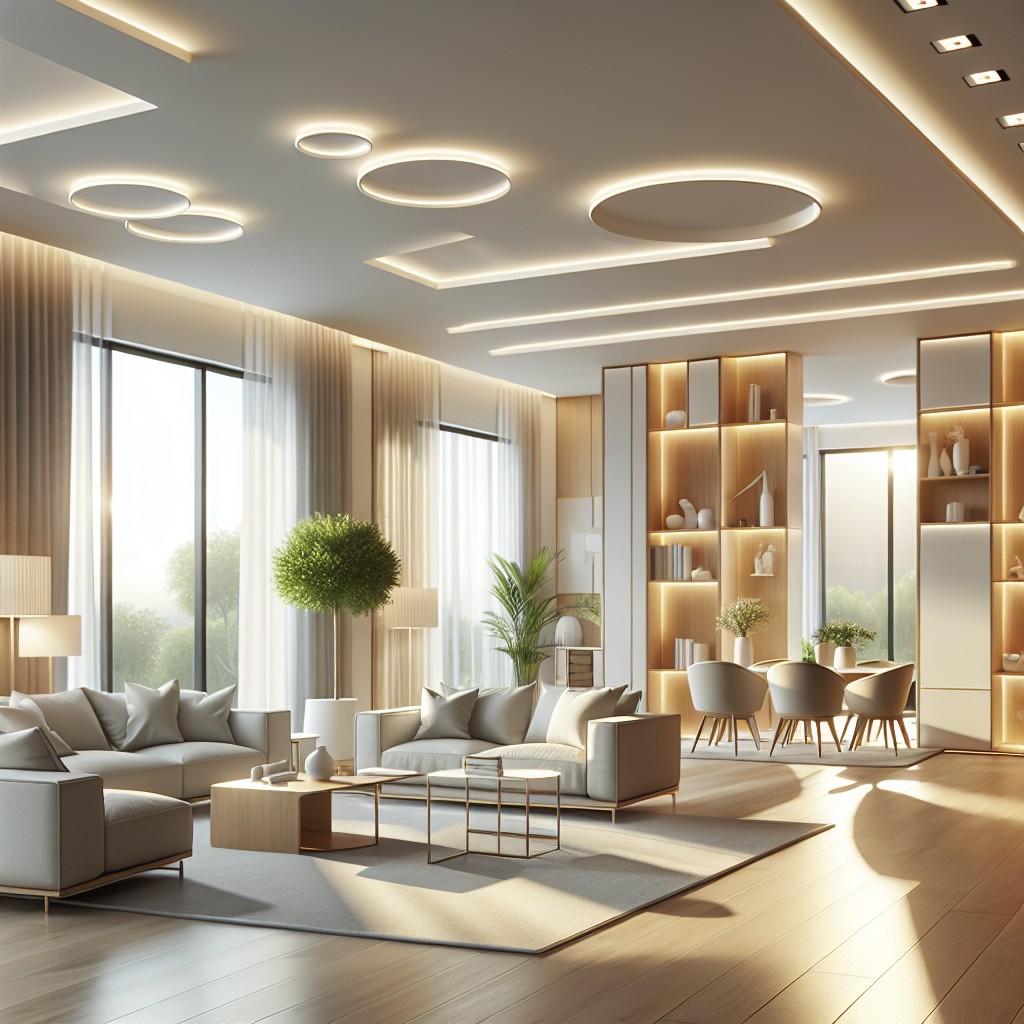
If you’re fully transitioned into the world of LED lighting, you’re likely familiar with the two main options on the color temperature spectrum: daylight and soft white. The selection between these versions comes down to the ambiance you’re aiming to create in your room.
Daylight LED bulbs emanate a bright, pure-white light, closely mimicking actual daylight. Ideal for rooms where a lot of detailed tasks take place, such as kitchens, bathrooms or study rooms, daylight LED recessed lights can intensify the liveliness and crispness of the space.
On the other end of the spectrum, soft white mimics the warm, yellow-white light given off by traditional incandescent bulbs. Use soft white where you want the space to have a quieter, cosier feel—think living rooms, bedrooms, and dining rooms.
Remember, both daylight and soft white LEDs offer remarkable energy efficiency and longevity. The key factor isn’t about better or worse, but rather, it centers around your preference and room’s functionality. With careful selection, you can use the different light temperatures to channel a particular mood, ultimately enhancing your home décor.
Environmental Impact of Using Daylight LED Recessed Lighting
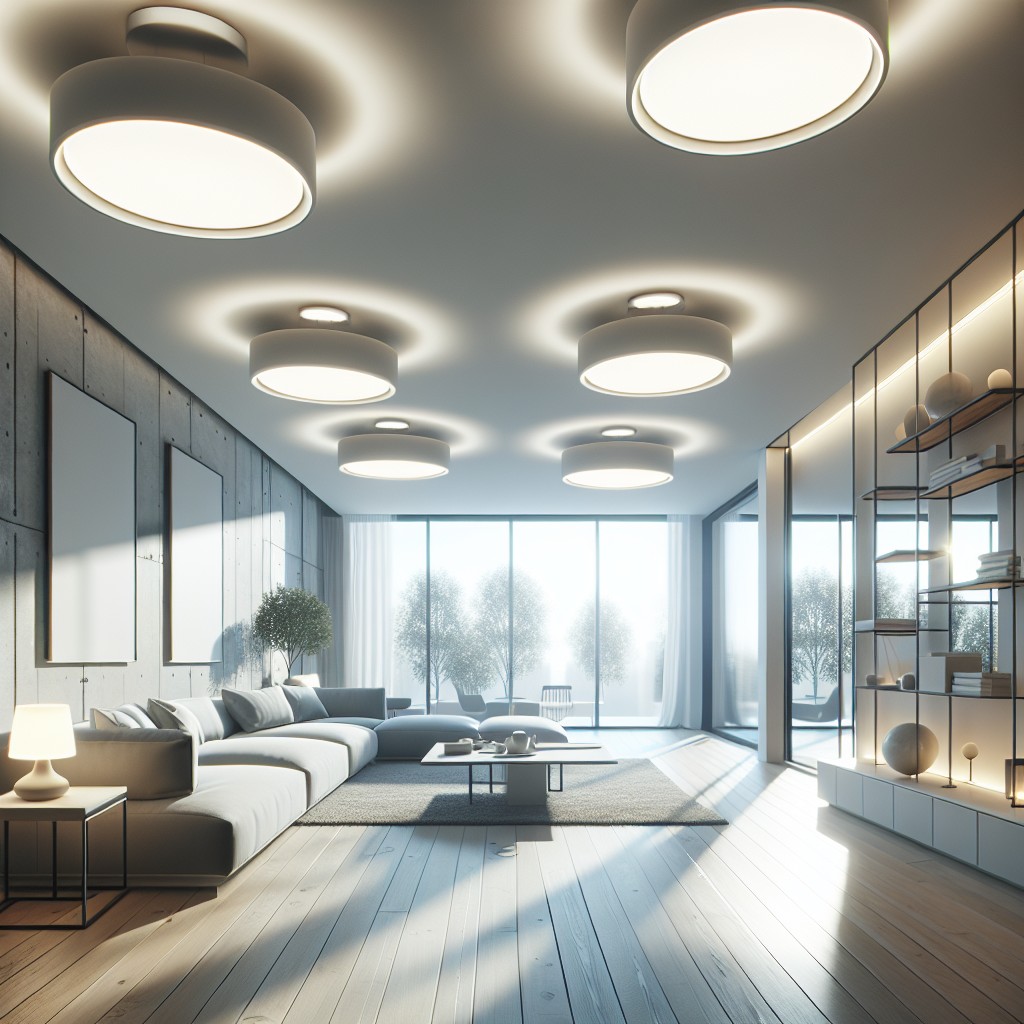
As eco-consciousness continues to shape buying decisions, the green credentials of daylight LED recessed lighting are worth exploring. Firstly, these bulbs consume significantly less power compared to traditional lights, which reduces your carbon footprint. A lower power consumption also equates to decreased demands on power plants, contributing less to greenhouse gas emissions.
A lower power consumption also equates to decreased demands on power plants, contributing less to greenhouse gas emissions.
Secondly, their lifespan far exceeds standard bulbs. This means less frequent replacements, reducing material consumption and associated waste.
Finally, unlike Compact Fluorescent Lamps (CFLs), LEDs do not contain harmful mercury, making their disposal safer for the environment. By going green with daylight LED recessed lights, you’re adding not only aesthetic appeal to your home, but also contributing to a more sustainable future.
The Importance of Daylight LED Recessed Lights in Workspace Design
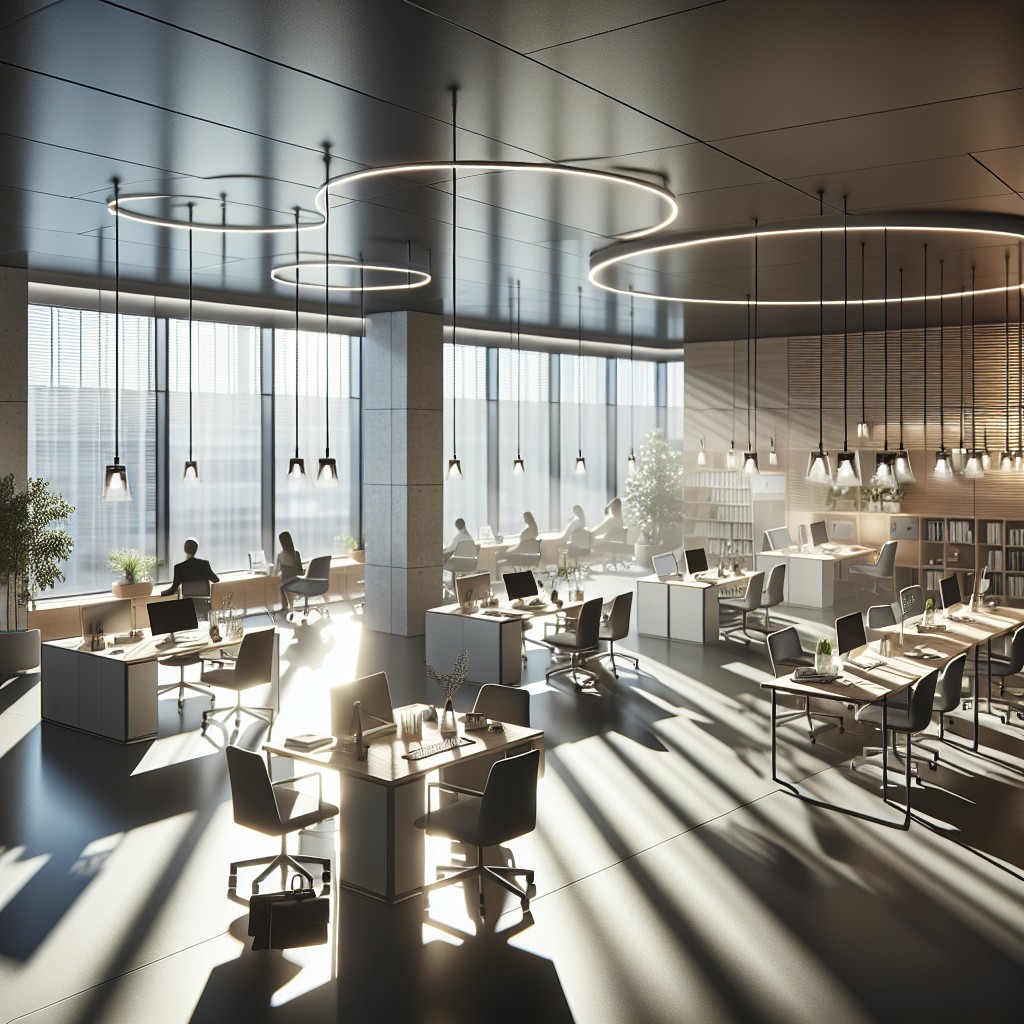
Creating a balanced and effective workspace design depends on several factors, one crucial element being the quality and nature of lighting. Daylight LED recessed lights are a modern solution favoring productivity and aesthetics.
These lights mimic natural daylight, reducing eye strain during prolonged screen time. Their minimalist design, built into the ceiling, means no bulb glare. They promote focus and comfort, key to any workspace.
Color accuracy is crucial in some fields like graphic design and photography. Daylight LED lights render colors more accurately compared to other types of lighting, improving artistic and professional precision.
Finally, LEDs use less energy and have a much longer lifespan, reducing costs over time. And being recessed, they deliver unobtrusive, professional aesthetics. Overall, bringing daylight LED recessed lights into workspace design sets the stage for a highly functional, efficient, and visually appealing environment.
Retrofitting Old Recessed Lighting With Daylight LED Bulbs
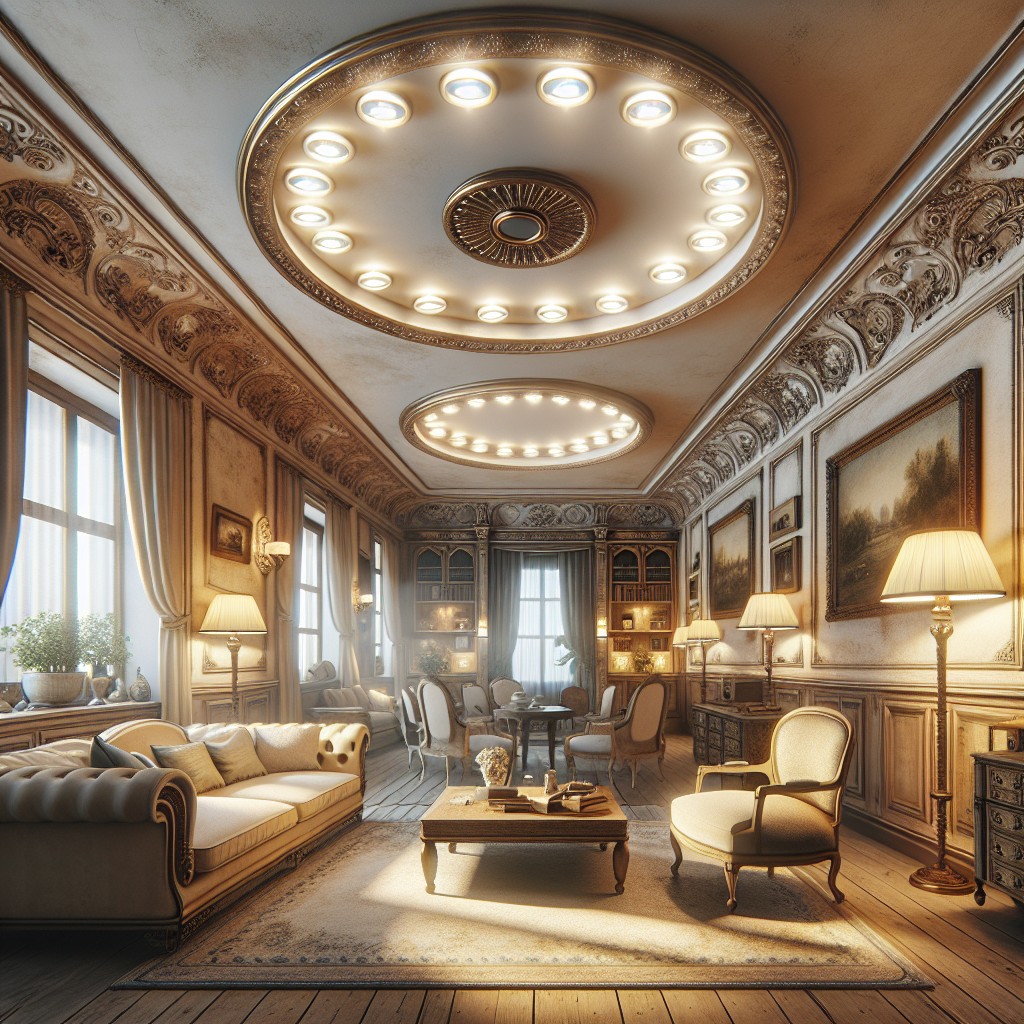
Initiating this retrofitting process can be a game changer for your home’s lighting atmosphere. Transitioning to LED lighting opens up the opportunity for improved quality and energy efficiency.
First things first, it’s vital to ensure that your existing recessed light fixtures are compatible with the new LED bulbs. Some housings may require an adapter, or even a brand new housing. Additionally, it’s important to note that dimmer switches require LED-compatible models to function properly.
Next, choose the watt equivalence to suit the amount of brightness desirable in each specific room. In bedrooms and living rooms, you might prefer bulbs equivalent to a traditional 60-watt, while in a kitchen it may serve better to select a brightness comparable with 100-watt incandescent bulbs.
Before replacing, always turn off power supply at the main switch to avoid any potential risks.
Now, you’re ready to screw in your new daylight LED bulbs where the old recessed lighting ones were. With a quick switch, you’ll achieve brighter, energy-efficient, and long-lasting lighting.
Achieving Balanced Lighting With Daylight LED Recessed Lights
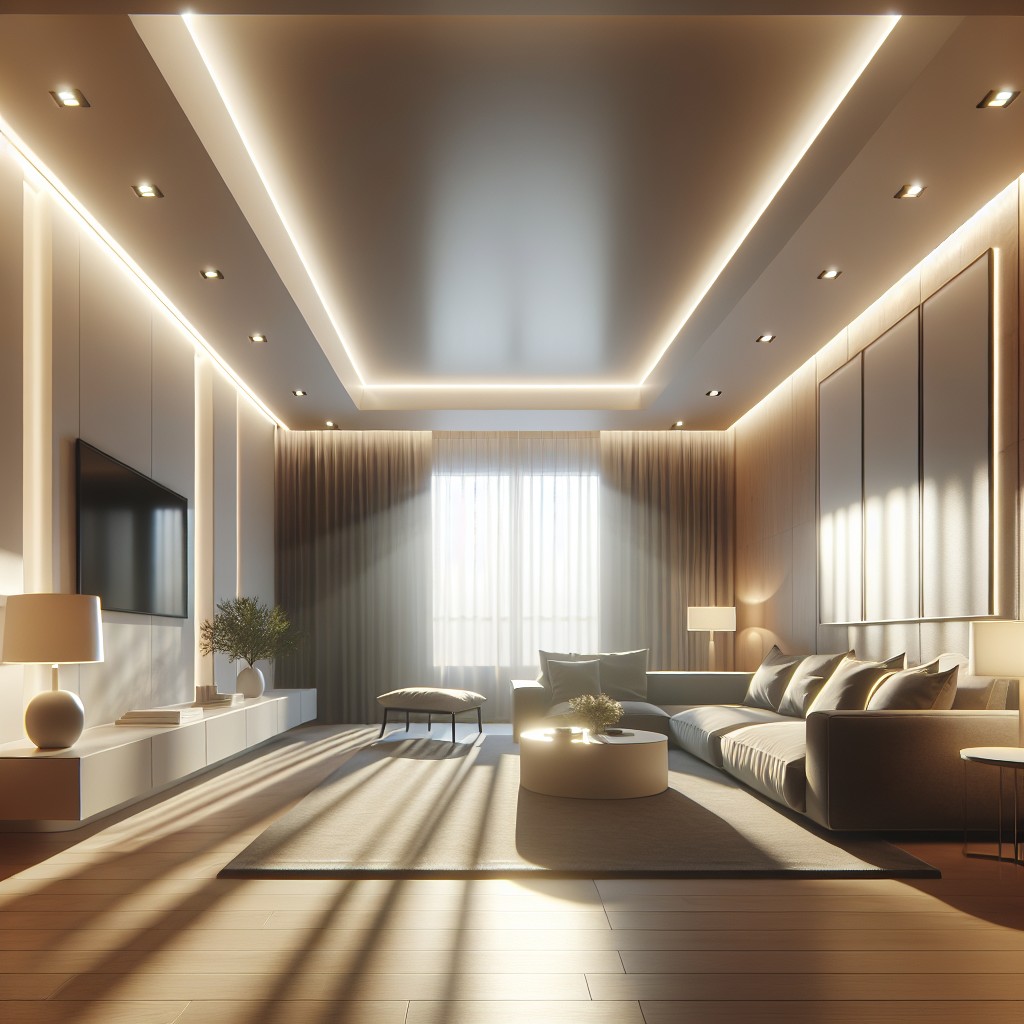
Balanced lighting plays a crucial role in creating a comfortable and functional living space. Here are some tips on how to accomplish that with daylight LED recessed lights:
1. Spacing: Strategically space your lights based on the size of the room to avoid hot spots and dark corners. The general rule of thumb is to place them approximately 3 feet away from the wall and 4 to 6 feet apart from each other.
2. Layering: Combine your daylight LEDs with other light sources. Capitalize on natural light, and complement it with task and accent lighting for a well-rounded lighting scheme.
3. Dimming: Use dimmer switches to have full control over the light intensity. Dimming allows you to adapt the lighting to various tasks and moods throughout the day.
4. Distribution: Make sure to distribute your light sources evenly. This concept helps to eliminate shadows and ensures overall light flow in the room.
Implementing these strategies will help you create a well-lit, inviting environment within your home.
Cost Factors When Switching to Daylight LED Recessed Lights
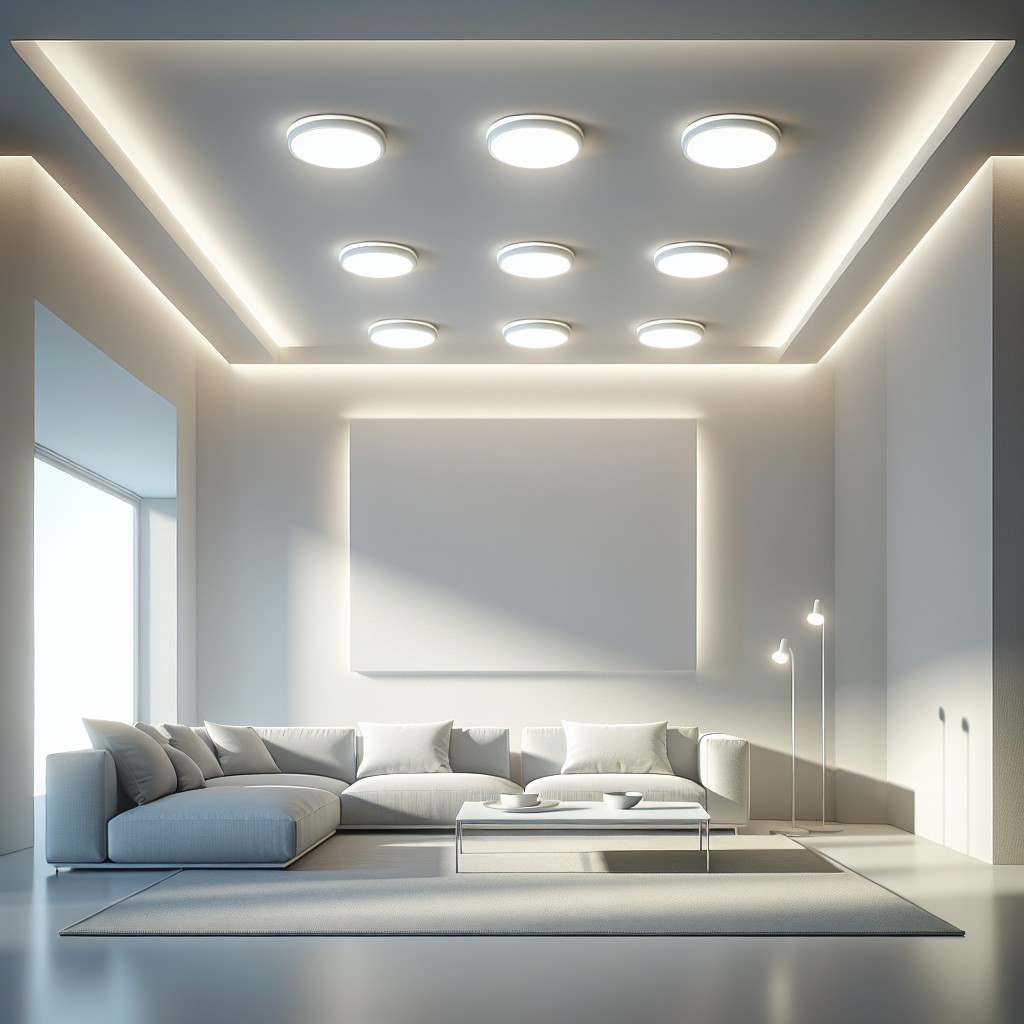
Firstly, consider the initial purchase price. Despite being higher than traditional bulbs, LED lights are economical in the long term. This is due to their high energy efficiency, resulting in significantly lower electricity bills.
Next, let’s talk about the replacement cost. Thanks to their exceptional lifespan, these bulbs often last for years before needing a replacement. This reduces the frequency and, thus, the cost of replacements.
Another factor is the cost of installation. If your home already possesses suitable fixtures, simply purchasing the bulbs and screwing them in warrants no additional cost. However, if new fixtures need to be installed or old ones modified, hiring a professional may be required, adding to the overall cost.
Finally, if you aim for color accuracy or particular lighting effects, higher-priced models might be required. Some premium bulbs feature advanced technologies offering superior light quality and smart features, which, while beneficial, come at a higher cost.
Regardless, investing in daylight LED recessed lights is budget-friendly and eco-conscious in the long run. With multiple energy-saving and long-lasting benefits, these lights prove their worth over time.
How Do Daylight LED Recessed Lights Affect Sleep Quality?
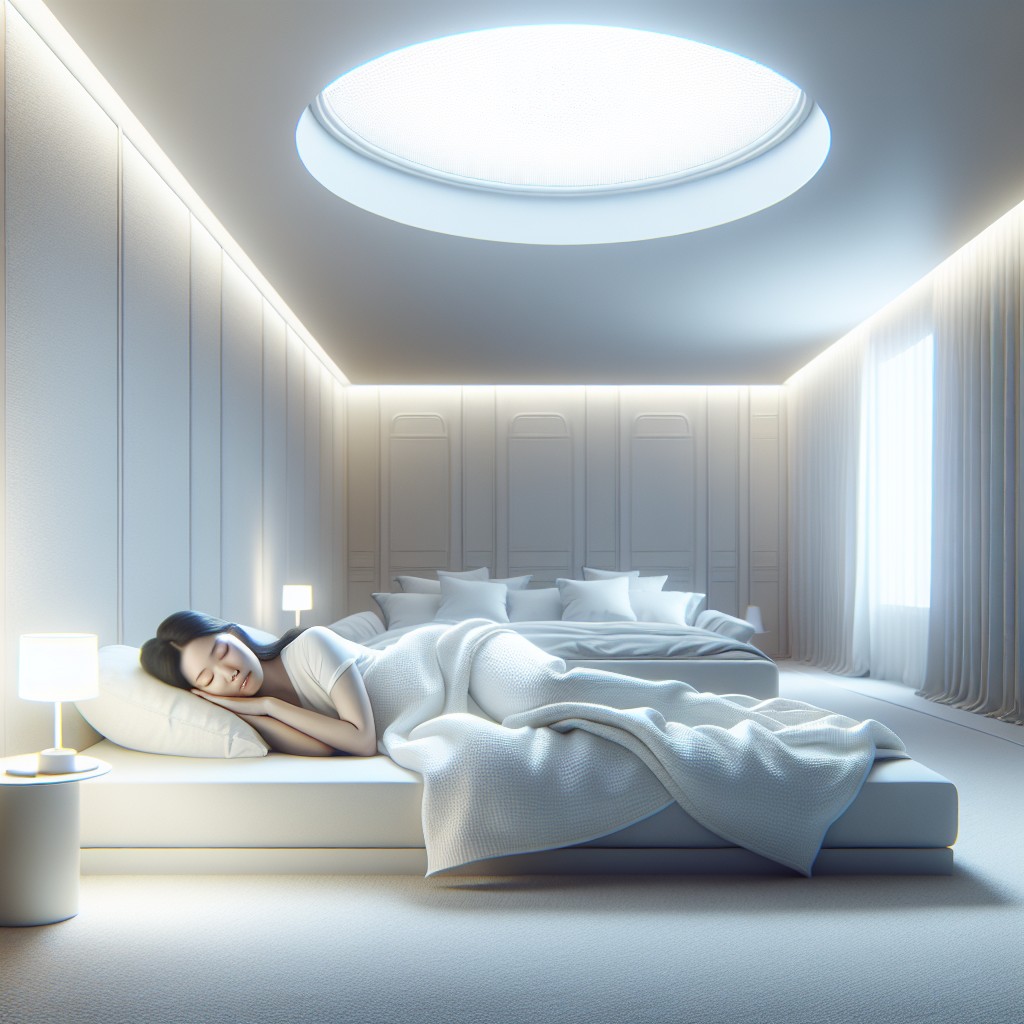
Scientific research suggests that exposure to daylight or white light during evening hours can impair sleep quality. The cool tone of daylight LED recessed lights closely mimics natural sunlight, and while excellent for focus and productivity, it’s not ideal for restful environments. Let’s examine closer.
1. Body Clock Disruption: Intense white light in the evenings can disrupt the body’s natural circadian rhythm, leading to sleep disturbances.
2. Melatonin Reduction: Exposure to daylight LED lights post sundown can suppress the secretion of melatonin – the hormone responsible for regulating sleep.
Given these impacts, the usage of daylight LEDs in bedrooms is not highly recommended, especially near bedtime. Strategically placing these lights in areas used primarily during daytime or where high levels of focus are required – like the kitchen or study room – can ensure their benefits are maximized without disturbing sleep. Alternatively, dimmable LEDs are a practical solution, allowing for the adjustment of light intensity to align with your daily rhythm.

